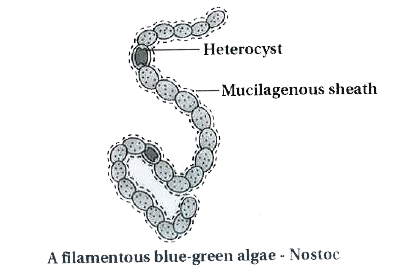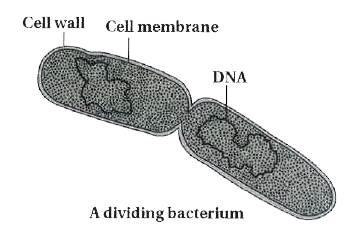Write short note on Eubacteria. Solution in Gujrati
Video Solution
Text Solution
Eubacteria : There are thousands of different eubacteria or true bacteria.
They are characterised by the presence of a rigid cell wall and if motile, a flagellum.
Cyanobacteria : The cyanobacteria (also referred to as blue-green algae) have chlorophyll a similar to green plants and are photosynthetic autotrophs.

Habitat: The cyanobacteria are unicellular, colonial or filamentous, freshwater/marine or terrestrial algae.
The colonies are generally surrounded by gelatinous sheath.
They often blooms in polluted water bodies.
Function: Some of these organisms can fix atmospheric nitrogen in specialised cells called heterocysts eg. Nostoc and Anabaena.
Chemosynthetic autotrophic bacteria : These bacteria oxidise various inorganic substances such as nitrates, nitrites and ammonia and use the released energy for their ATP production
They play a great role in recycling nutrients like nitrogen, phosphorous, iron and sulphur.
Heterotrophic bacteria : These bacteria are the most abundant in nature.
The majority are important decomposers.
Many of them have a significant impact on human affairs.
They are helpful in making curd from milk, production of antibiotics, fixing nitrogen legume roots etc.
Some are pathogens causing damage to human beings, crops, farm animals and pets.
Cholera, typhoid, tetanus, citrus canker are well known diseases caused by different bacteria.
Reproduction : Bacteria reproduce mainly by fission. Sometimes under unfavourable conditions they produce spores.
They also reproduce by a sort of sexual reproduction by adopting a primitive type of DNA transfer from one bacterium to the other.

Mycoplasma : The mycoplasma are organisms that completely lack a cell wall.
They are the smallest living cells known and can survive without oxygen.
Many mycoplasma are pathogenic in animals and plants.
Mycoplasma are the simplest free living prokaryotes.
They are also known as PPLO (pleuropneumonia like organism).
Types of Eubacteria : Eubacteria are typically classified into five different phylums : Chlamdias, cyanobacteria (Blue-green algae), Gram-positive bacteria, proteobacteria and spirochetes.
Chlamydias are often parasitic bacteria.
Cyanobacteria are most commonly known to be aquatic and obtain energy via photosynthesis.
Some, but not all bacteria have an additional layer enclosing the cell wall referred to as the lipopolysaccharide or LPS layers.
This extra layer cannot be dyed with a gram stain that is often used to classify bacteria by researchers and are thus referred to as Gram negative bacteria or Proteobacteria.
Proteobacteria make up the second largest group of bacteria and they can be stained by the dye.
These bacteria are referred to as gram positive.
Spirochetes are long, thin, spiral shaped bacteria that are known to cause Lyme disease.
They are distinct from the other types of bacteria due to their helical shape and movement.
They typically move by spinning along their axis.
|
Updated on:21/07/2023
Topper's Solved these Questions
- BOOK - KUMAR PRAKASHANCHAPTER - BIOLOGICAL CLASSIFICATIONEXERCISE - SECTION - B (DIFFERENCE/SCIENTIFIC REASONS)14videos
BIOLOGICAL CLASSIFICATION
- BOOK - KUMAR PRAKASHANCHAPTER - BIOLOGICAL CLASSIFICATIONEXERCISE - SECTION - C (DEFINITION/EXPLANATION - TERMS/FULL NAME/IMPORTANCE/CONTRIBUTION OF SCIENTISTS)34videos
BIOLOGICAL CLASSIFICATION
- BOOK - KUMAR PRAKASHANCHAPTER - ANIMAL KINGDOMEXERCISE - OBJECTIVE SECTION (FILL IN THE BLANKS)10videos
ANIMAL KINGDOM
- BOOK - KUMAR PRAKASHANCHAPTER - BIOMOLECULES EXERCISE - QUESTION PAPER (DESCRIBE IN DETAIL):1videos
BIOMOLECULES
Similar Questions
Difference between Three Domains
View SolutionDefinitions/Explanation:
ParamylonView SolutionTeeth are modified ........... which are ........... directed
01:36View SolutionExplain chemical analysis.
02:03View SolutionWrite short notes on the Electroplating.
01:12View SolutionWrite a short notes on hyperconjugation.
03:44View SolutionWrite a short note no data.
02:54View SolutionWRITE SHORT NOTES ON : Grafting
04:28View SolutionWRITE SHORT NOTES ON : Ecosystem,
02:52View SolutionWrite short note on FAO
04:44View SolutionWrite short notes on Frankia
05:03View SolutionWrite short notes on starch.
02:53View Solution

